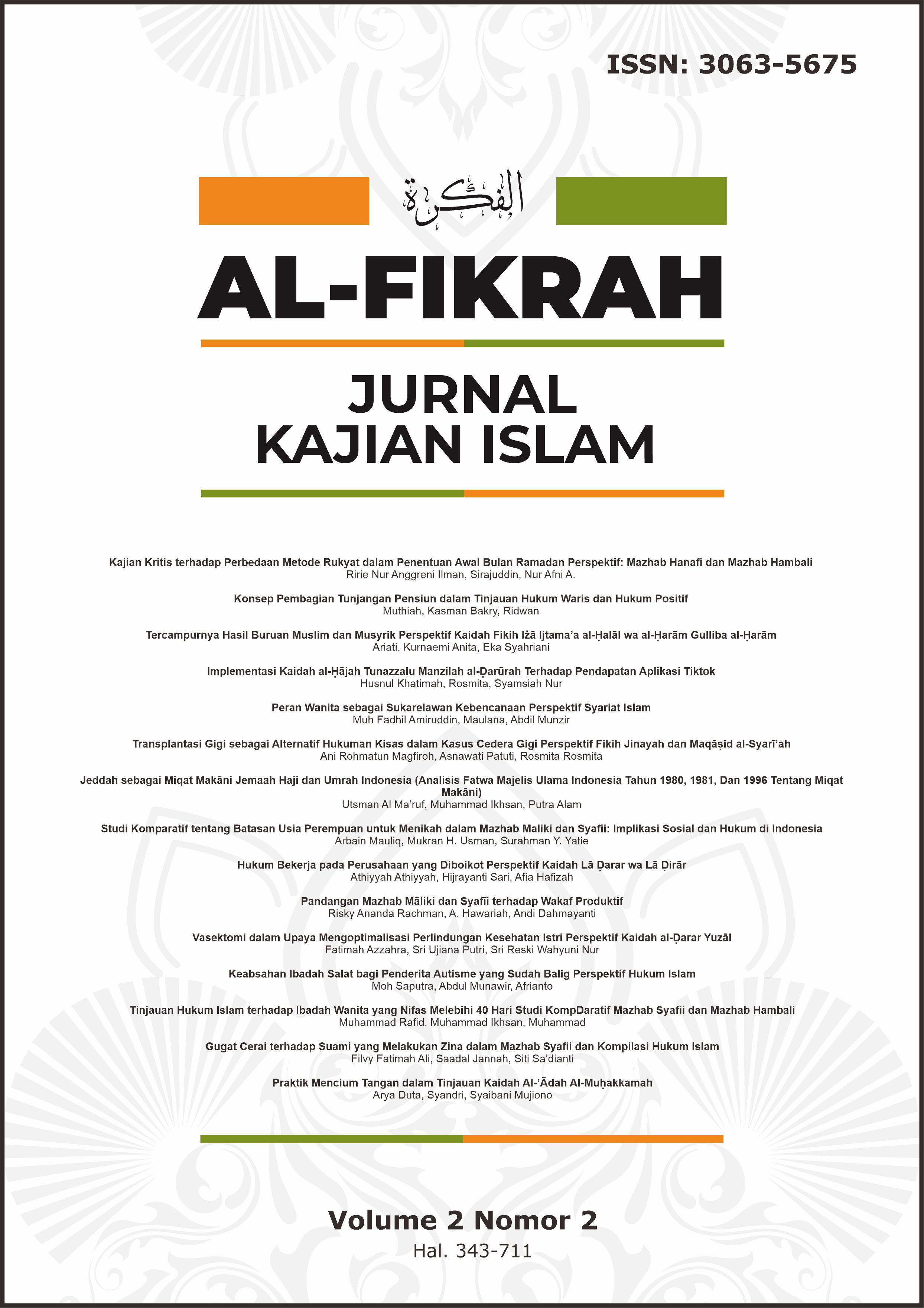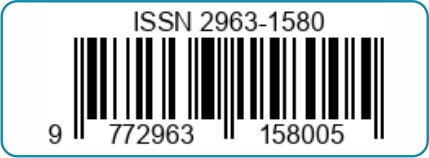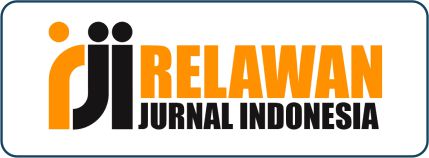Transplantasi Gigi sebagai Alternatif Hukuman Kisas dalam Kasus Cedera Gigi Perspektif Fikih Jinayah dan Maqāṣid al-Syarī’ah
Tooth Transplantation as an Alternative to Kisas Punishment in Cases of Dental Injury Perspective of Jinayah Jurisprudence and Maqāṣid al-Syarī’ah
DOI:
https://doi.org/10.36701/fikrah.v2i2.2362Keywords:
Jinayah Fiqh, Maqāṣid al-Syarī‘ah, kisas, Tooth TransplantationAbstract
Advances in modern medicine have provided various recovery methods for victims of physical violence, including dental injuries. This has given rise to a new discourse in Islamic jurisprudence (jurisprudence) regarding the possibility of medical reconstruction as part of fulfilling victims' rights to justice. This study aims to analyze the perspectives of Islamic jurisprudence (jurisprudence) and the principles of Islamic law (maqāṣid al-syarī‘ah) on the possibility of tooth transplantation as a substitute for kyas punishment in cases of dental injuries. This study employed a qualitative method with a library research approach, a normative approach, and the principles of Islamic law (maqāṣid al-syarī‘ah). Data sources were reviewed from various Islamic jurisprudence books, contemporary Islamic literature, and relevant scientific journals. The analysis was conducted using a descriptive-qualitative approach. The results of this study indicate that, first, from a jurisprudence perspective, tooth transplantation does not yet qualify as a form of qaḍā’ī-permissible revenge, because qaṭ‘ī is a sharia-based legal provision, as affirmed in Q.S. al-Mā’idah: 45. Its implementation requires a definite and fair equality between the injuries suffered by the victim and the retaliation against the perpetrator. In medical practice, the results of tooth transplantation cannot guarantee absolute equality, and therefore cannot replace the implementation of legal revenge. Second, from a maqāṣid al-sharī‘ah perspective, tooth transplantation especially those using donors from other individuals (allografts) has the potential to pose medical risks such as infection and tissue rejection. These risks contradict the sharia principle of lā ḍarar wa lā ḍirār (not to cause harm and not to cause harm to others). Therefore, transplantation can only be positioned as a form of peaceful settlement (ṣulḥ) in Islamic criminal law, carried out based on a voluntary agreement between the victim and the perpetrator after forgiveness is granted. This research contributes to the development of contemporary Islamic jurisprudence by emphasizing the importance of integrating sharia provisions and medical considerations in addressing the dynamics of bodily injury cases.
Downloads
References
Buku:
‘Abd al-Karīm Zaydān. Qiṣāṣ wa al-Diyāt fī al-Syarī‘ah al-Islāmiyyah. Cet. I. Damaskus: Mu’assasah al-Risālah Nāsyirūn, 2013.
‘Abd al-Qādir ‘Awdah. At-Tasyri‘ al-Jinā’ī al-Islāmī. Jilid 2. Beirut: Dār al-Kitab al-‘Arabi, 1998.
Ahmad ‘Abd al-‘Azīz. Al-Fiqh al-Jinā’ī fī al-Islām: Ḍarūrāt al-Qatl, al-Qiṣāṣ, al-Diyāt, al-Ḥudūd, al-Ta‘zīrāt, Amṯilah wa Taṭbīqāt Naẓariyyah. Cet. I. Kairo: Dār al-Salām, 1417 H/1997 M.
Ahmad al-Raysuni. Naẓariyyat al-Maqāṣid ‘inda al-Imām al-Shāṭibī. Beirut: Dār al-Nāfīsat, 1995.
‘Abdullāh bin Ibrāhīm al-Ṭarīqī. Al-Ta’āmulu Ma’a Gairi al-Muslimīn. Juz 1. Riyāḍ: Dār al-Faḍīlah, 1428 H/2007 M.
Amir ‘Abdul ‘Azīz. Al-Fiqh al-Jinā’ī fī al-Islām: Dhurūb al-Qatl, al-Qiṣāṣ, al-Diyāt, al-Ḥudūd, al-Ta‘zīrāt, Amṡilah wa Taṭbīqāt Naẓariyyah. Cet. I. Kairo: Dār al-Salām, 1417 H/1997 M.
Hani Sayyid As-Sibā‘ī. Al-Qiṣāṣ: Dirāsah fī al-Fiqh al-Jinā’ī al-Muqāran. Cet. I. London: Markaz al-Maqrīzī li al-Dirāsāt al-Tārīkhiyyah, 1425 H/2004 M.
Ḥasan bin Muḥammad Safar. Nazarāt Istisrāfiyah Fi Fiqhi al-‘Alaqāt al-Insāniyah Baina Muslimin Wa Gairi al-Muslimin. Riyadh: Wizārah al-Auqāf al-Su‘ūdiyyah, t.th.
Hasbi Umar. Nalar Fiqih Kontemporer. Jakarta: Gaung Persada Press, 2007.
Ibnu Manzhūr. Lisān al-‘Arab. Jilid 18. Kairo: Dār al-Maṣriyyah li al-Taʾlīf, t.t.
Ibnu Qudāmah al-Maqdisī. Al-Mughnī. Juz 9. Beirut: Dār al-Fikr, t.t.
Jasser Auda. Maqasid al-Shariah as Philosophy of Islamic Law: A Systems Approach. London: IIIT, 2008.
Jusuf Hanafiah dan Amri Amir. Etika Kedokteran dan Hukum Kesehatan. Jakarta: Penerbit tidak disebutkan.
Kementerian Agama Republik Indonesia. Al-Qur’an dan Terjemahannya. Jakarta: Lajnah Pentashihan Mushaf Al-Qur’an, 2019.
Al-Kāsānī. Badā’iʿ al-Ṣanā’iʿ. Jilid 7. Beirut: Dar al-Fikr, t.t.
Majma’ al-Fiqh al-Islami. Qararat wa Tausiyyat. Jeddah: OIC, 2006.
Muhammad Yasir, ed. Fikih Kedokteran Kontemporer. Cet. I. Jakarta Timur: Al-Kautsar, 2018.
Al-Qurthubi. Al-Jāmi‘ li Aḥkām al-Qur’ān. Jilid II. Beirut: Dār al-Kutub al-‘Ilmiyyah, 2006.
Soerjono Soekanto dan Sri Mamudji. Penelitian Hukum Normatif: Suatu Tinjauan Singkat. Jakarta: Rajawali Pers, 2014.
Surjiyo dkk. Dasar-dasar Logika. Cet. 3. Jakarta: Bumi Aksara, 2008.
Thomas Starzl. The Puzzle People: Memoirs of a Transplant Surgeon. Pittsburgh: University of Pittsburgh Press, 1992.
Wahbah al-Zuḥaylī. Al-Fiqh al-Islāmī wa Adillatuhu. Jilid 6. Cet. ke-4. Beirut: Dār al-Fikr, 2013.
Jurnal
Rosmini, A., Qadri Gassing, dan M. Marilang. “Transplantasi Organ Tubuh Perspektif Fikih Kontemporer.” Jurnal Al-Qadāu 9, no. 1 (2022): 16–29.
Robiah, Irna Saputri, dan Muhammad Febriansyah. “Hukum Fikih tentang Transplantasi Organ: Perspektif Maqāṣid al-Syarī‘ah.” JETISH: Journal of Education Technology Information Social Sciences and Health 4, no. 1 (2025): 631–638.
Ramly, Amin. “Transplantasi Organ Tubuh sebagai Pengganti Hukuman Qishas dalam Hukum Islam (Studi Terhadap Delik Pelukaan Mata).” Jurnal SASI 25, no. 2 (2019): 146–154.
Nursanthy, Aji Titin Roswitha. “Transplantasi Organ Tubuh Manusia dalam Perspektif Hukum Islam.” Jurnal Ilmu Hukum The Juris 4, no. 1 (Juni 2020): 1–11.
Putri, Tiara Maharani Enifa, Laily Rahmina, dan Shalsa Mutia. “Transplantasi Organ Tubuh Manusia dalam Perspektif Etika Kedokteran dan Agama Islam.” Jurnal Religion: Jurnal Agama, Sosial, dan Budaya 2, no. 4 (2023): 1184–1197.
Downloads
Published
Issue
Section
License
Copyright (c) 2025 Ani Rohmatun Magfiroh, Asnawati Patuti, Rosmita Rosmita

This work is licensed under a Creative Commons Attribution-NonCommercial-ShareAlike 4.0 International License.










